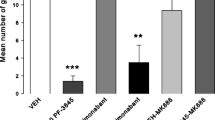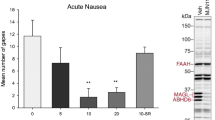Abstract
Rationale
Enhancement of the endocannabinoid (EC) system may reduce anticipatory nausea (AN).
Objectives
The experiments evaluated the potential of the dual fatty acid amide hydrolase (FAAH)/monoacylglycerol lipase (MAGL) inhibitor, JZL195, on its own and combined with anandamide (AEA) and 2-arachidonoyl glycerol (2-AG) to reduce contextually elicited gaping, a measure of AN in rats.
Methods
Following four context lithium chloride (LiCl) pairings, rats were injected with vehicle (VEH) or JZL195 (10 mg kg–1, intraperitoneally) 105 min before an injection of VEH, 2-AG (1.25 mg kg–1), or AEA (5.0 mg kg–1). Fifteen minutes later, all rats were placed in the LiCl-paired context for 5 min and in a different context for a 15-min locomotor test. Whole brains were extracted for EC analysis. The potential of the CB1 antagonist, SR141716, to reverse the suppression of AN by both JZL195 and AEA and of the CB2 antagonist, AM630, to reverse the suppression of AN by JZL195 was then evaluated.
Results
JZL195 suppressed gaping and elevated AEA, palmitoylethanolamine, and oleoylethanolamide. As the suppression of gaping was reversed by SR141716, but not by AM630, the effect was CB1 mediated. The suppressive effect of JZL195 on gaping, as well as elevation of AEA and 2-AG, was amplified by pretreatment with either AEA or 2-AG. On its own, AEA, but not 2-AG, also suppressed gaping—an effect that was also prevented by CB1 antagonism.
Conclusions
JZL195 reduces AN primarily by acting as a FAAH inhibitor, but MAGL inhibition is also indicated.




Similar content being viewed by others
References
Akechi T, Okuyama T, Endo C, Sagawa R, Uchida M, Nakaguchi T et al (2010) Anticipatory nausea among ambulatory cancer patients undergoing chemotherapy: prevalence, associated factors, and impact on quality of life. Cancer Sci 101:2596–2600
Blankman JL, Simon GM, Cravatt BF (2007) A comprehensive profile of brain enzymes that hydrolyze the endocannabionoid 2-arachidonoylglycerol. Chem Biol 14:1347–1356
Cross-Mellor SK, Ossenkopp KP, Piomelli D, Parker LA (2007) Effects of the FAAH inhibitor, URB597, and anandamide on lithium-induced taste reactivity responses: a measure of nausea in the rat. Psychopharmacology (Berl) 190:135–143
Darmani NA (2002) The potent emetogenic effects of the endocannabinoid, 2-AG (2 arachidonoylglycerol) are blocked by delta (9)-tetrahydrocannabinol and other cannabinoids. J Pharmacol Exp Ther 300:34–42
Darmani NA, McClanahan BA, Trinh C, Petrosino S, Valenti M, DiMarzo V (2005) Cisplatin increases brain 2-arachidonoylglycerol (2-AG) and concomitantly reduces intestinal 2-AG and anandamide levels in the least shrew. Neuropharmacology 49:502–513
Deutsch DG, Chin SA (1993) Enzymatic synthesis and degradation of anandamide, a cannabinoid receptor agonist. Biochem Pharmacol 46:791–796
Devane WA, Hanus L, Bruer A, Pertwee RG, Stevenson LA, Griffin G et al (1992) Isolation and structure of a brain constituent that binds to the cannabinoid receptor. Science 258:1946–1949
Dinh TP, Carpenter D, Leslie FM, Freund TF, Katona I, Sensi SL et al (2002) Brain monoglyceride lipase participating in endocannabinoid inactivation. Proc Natl Acad Sci U S A 99:10819–10824
Fegley D, Gaetani S, Duranti A, Tontini A, Mor M, Tarzia G et al (2005) Characterization of the fatty acid amide hydrolase inhibitor cyclohexyl ceramic acid 3′-carbamolyl-biphenyl-3-yl ester (URB597): effects on anandamide and oleoylethanolamide deactivation. J Pharmcol exp Ther 313:352–358
Foubert J, Vaessen G (2005) Nausea: the neglected symptom? Eur J ONcol Nurs 9:21–32
Gaetani S, Kaye WH, Cuomo V, Piomelli D (2008) Role of endocannabinoids and their analogues in obesity and eating disorders. Eat Weight Disorders 13:e42–e48
Garcia J, Hankins WG, Rusiniak KW (1974) Behavioral regulation of the milieu interne in man and rat. Science 185:824–831
Gobbi G, Bambico FR, Mangieri R, Bortolato M, Campolongo P, Solinas M et al (2005) Antidepressant-like activity and modulation of brain monoaminergic transmission by blockade of anandamide hydrolysis. Proc Natl Acad Sci U S A 102:18620–18625
Grill HJ, Norgren R (1978) The taste reactivity test. I. mimetic responses to gustatory stimuli in neurologically normal rats. Brain Res 143:263–279
Guindon J, Lai Y, Takacs SM, Bradshaw HB, Hohmann AG (2013) Alterations in endocannabinoid tone following chemotherapy-induced peripheral neuropathy: effects of endocannabinoid deactivation inhibitors targeting fatty-acid amide hydrolase and monoacylglycerol lipase in comparison to reference analgesics following cisplatin treatment. Pharm Res 67:94–109
Kathuria S, Gaetani S, Fegley D, Valino F, Duranti A, Tontini A et al (2003) Modulation of anxiety through blockade of anandamide hydrolysis. Nat Med 9:76–81
Kinsey SG, Long JZ, O’Neal ST, Abdullah RA, Poklis JL, Boger DL, Cravatt BF, Lichtman AH (2009) Blockade of endocannabinoid-degrading enzymes attenuates neuropathic pain. J Pharmacol Exp Ther 330:902–910
Kinsey SG, Wise LE, Ramesh D, Abdullah RA, Selley DE, Cravatt BF, Lichtman AH (2013) Repeated low dose administration of the monoacylglycerol lipase inhibitor JZL184 retains CB1 receptor mediated antinociception and gastroprotective effects. J of Pharmacol Exp Ther 345:492–501
Lichtman AH, Leung D, Shelton CC, Saghatelian A, Hardouin C, Boger DL, Cravatt BF (2004) Reversible inhibitors of fatty acid amide hydrolase that promote analgesia: evidence for an unprecedented combination of potency and selectivity. J Pharmacol Exp Ther 311:441–448
Limebeer CL, Hall G, Parker LA (2006) Exposure to a lithium-paired context elicits gaping in rats: a model of anticipatory nausea. Physiol Behav 88:398–403
Limebeer CL, Krohn JP, Cross-Mellor S, Litt DE, Ossenkopp KP, Parker LA (2008) Exposure to a context previously associated with nausea elicits conditioned gaping in rats: a model of anticipatory nausea. Behav Brain Res 187:33–40
Long JZ, Nomura DK, Vann RE, Walentiny DM, Booker L, Jin X et al (2009a) Dual blockade of FAAH and MAGL identifies behavioral processes regulated by endocannabinoid crosstalk in vivo. Proc Natl Acad Sci U S A 106:20270–20275
Long JZ, Li W, Booker L, Burston JJ, Kinsey SG, Schlosburg JE et al (2009b) Selective blockade of 2-arachidonoylglycerol hydrolysis produces cannabinoid behavioral effects. Nat Chem Biol 5:37–44
Malik IA, Khan WA, Qazilbash M, Ata E, Butt A, Khan MA (1995) Clinical efficacy of lorazepam in prophylaxis of anticipatory, acute, and delayed nausea and vomiting induced by high doses of cisplatin. A prospective randomized trial. Am J Clin Oncol 18L:170–175
Mazzola D, Medalie J, Scherma M, Panlilio LV, Solinas M, Tanda G et al (2009) Fatty acid amide hydrolase (FAAH) inhibition enhances memory acquisition through activation of PPAR-alpha nuclear receptors. Learn Mem 16:332–337
Mechoulam R, Ben-Shabat S, Hanus L, Ligumsky M, Kaminski NE, Schatz AR et al (1995) Identification of an endogenous 2-monoglyceride, present in canine gut that binds to cannabinoid receptors. Biochem Pharmacol 50:83–90
Morrow GR, Roscoe JA, Kirshner JJ, Hynes HE, Rosenbluth RJ (1998) Anticipatory nausea and vomiting in the era of 5-HT3 antiemetics. Support Care Cancer 6:244–247
Neese R, Carli T, Curtis GC, Kleinman PD (1980) Pretreatment nausea in cancer chemotherapy: a conditioned response? Psychosom Med 42:33–36
Parker LA, Kemp SW (2001) Tetrahydrocannabinol (THC) interferes with conditioned retching in Suncus murinus: an animal model of anticipatory nausea and vomiting (ANV). Neuroreport 12:749–751
Parker LA, Kwiatkowska M, Mechoulam R (2006) Delta-9-tetrahydrocannabinol and cannabidiol, but not ondansetron, interfere with conditioned retching reactions elicited by a lithium-paired context in Suncus murinus: an animal model of anticipatory nausea and vomiting. Physiol Behav 87:66–71
Parker LA, Limebeer CL, Rana SA (2009a) Conditioned disgust, but not conditioned taste avoidance, may reflect conditioned nausea in rats. In: Reilly S, Schachtman TR (eds) Conditioned taste aversions: behavioral and neural processes. Oxford University Press, New York
Parker LA, Limebeer CL, Rock EM, Litt DL, Kwiatkowska M, Piomelli D (2009b) The FAAH inhibitor URB-597 interferes with cisplatin- and nicotine- induced vomiting in the Suncus murinus (house musk shrew). Physiol Behav 97:121–124
Parker LA, Rock EM, Limebeer CL (2011) Regulation of nausea and vomiting by cannabinoids. Br J Pharmacol 163:1411–1422
Ramesh D, Ross G, Schlosburg JE, Owens RA, Abdullah RA, Kinsey SG, Long JZ, Nomura DK, Sim-Selley LJ, Cravatt BF, Akbarali HI, Lichtman AH (2011) Blockade of endocannabinoid hydrolytic enzymes attenuates precipitated opioid withdrawal symptoms in mice. J Pharmacol Exp Ther 339:173–185
Razavi D, Delvaux N, Farvacques C, DeBrier F, Van Heer C, Kaufman L et al (1993) Prevention of adjustment disorders and anticipatory nausea secondary to adjuvant chemotherapy: a double-blind, placebo-controlled study assessing the usefulness of alprazolam. J Clin Oncol 11:1384–1390
Reagan-Shaw S, Nihal M, Ahmad N (2007) Dose translation from animal to human studies revisited. FASEB 22:659–662
Rock EM, Limebeer CL, Mechoulam R, Piomelli D, Parker LA (2008) The effect of cannabidiol and URB597 on conditioned gaping (a model of nausea) elicited by a lithium-paired context in the rat. Psychopharmacology (Berl) 196:389–395
Sharkey KA, Cristino L, Oland LD, Van Sickle MD, Starowicz K, Pittman QJ et al (2007) Arvanil, anandamide and N-arachdonolyl-dopamine (NADA) inhbiti emesis through cannabinoid CB1 and vanilloid TRPV1 receptors in the ferret. Eur J Neurosci 25:2773–2782
Sticht MA, Rock EM, Parker LA (2013) 2-Arachidonoylglycerol (2-AG) interferes with Lithium Chloride induced vomiting in the house musk shrew, Suncus murinus. Physiol Behav, 120C:228-232
Sticht MA, Long JZ, Rock EM, Limebeer CL, Mechoulam R, Cravatt BF, Parker LA (2012) Inhibition of monoacylglycerol lipase attenuates vomiting in Suncus murinus and 2-arachidonoyl glycerol attenuates nausea in rats. Br J Pharmacol 165:2425–2435
Sulcova E, Mechoulam R, Fride E (1998) Biphasic effects of anandamide. Pharmacol Biochem Behav 59:347–352
Travers JB, Norgren R (1986) Electromyographic analysis of the ingestion and rejection of sapid stimuli in the rat. Behav Neurosci 100:544–555
Van Sickle MD, Duncan M, Kingsley PJ, Mouihate A, Urbani P, Mackie K et al (2005) Identification and functional characterization of brainstem cannabinoid CB2 receptors. Science 310:329–332
Varvel SA, Wise LE, Niyuhire F, Cravatt BF, Lichtman AH (2007) Inhibition of fatty-acid amide hydrolase accelerates acquisition and extinction rates in a spatial memory task. Neuropsychopharm 32:1032–1041
Wise LE, Harloe JP, Lichtman AH (2009) Fatty acid amide hydrolase (FAAH) knockout mice exhibit enhanced acquisition of an aversive, but not of an appetitive Barnes task. Neurobiol Learn Mem 92:597–601
Wise LE, Long KA, Abdullah RA, Long JZ, Cravatt BF, Lichtman AH (2012) Dual fatty acid amide hydrolase and monoacylglycerol lipase blockade produces THC-like Morris water maze deficits in mice. ACS Chem Neurosci 3:369–378
Wiskerke J, Irimia C, Cravatt BF, De Vries TJ, Schoffelmeer AN, Pattij T, Parsons LH (2012) Characterization of the effects of reuptake and hydrolysis inhibition on interstitial endocannabinoid levels in the brain: an in vivo microdialysis study. ACS Chem Neurosci 3:407–417
Acknowledgments
This study was supported by a research grant from the Natural Sciences and Engineering Council of Canada to L. Parker.
Author information
Authors and Affiliations
Corresponding author
Rights and permissions
About this article
Cite this article
Limebeer, C.L., Abdullah, R.A., Rock, E.M. et al. Attenuation of anticipatory nausea in a rat model of contextually elicited conditioned gaping by enhancement of the endocannabinoid system. Psychopharmacology 231, 603–612 (2014). https://doi.org/10.1007/s00213-013-3282-7
Received:
Accepted:
Published:
Issue Date:
DOI: https://doi.org/10.1007/s00213-013-3282-7




